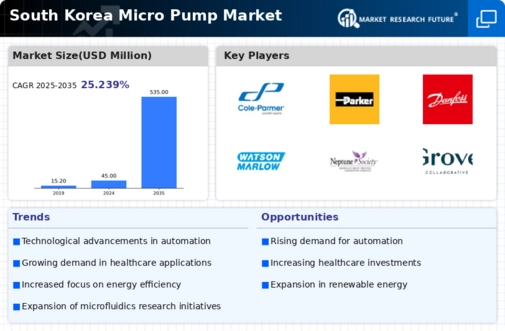Expansion of the Automotive Sector
The automotive sector in South Korea is undergoing a significant transformation, with a growing focus on electric vehicles (EVs) and advanced automotive technologies. This shift is likely to impact the micro pump market industry positively, as micro pumps are increasingly utilized in various automotive applications, including fuel delivery and cooling systems. The South Korean automotive market is projected to reach $50 billion by 2025, with a substantial portion allocated to innovative technologies. As manufacturers seek to enhance vehicle performance and efficiency, the demand for micro pumps is expected to rise. This trend indicates a promising opportunity for the micro pump market, as automotive companies integrate these devices into their systems.
Rising Demand in Healthcare Sector
The healthcare sector in South Korea is experiencing a notable increase in demand for advanced medical devices, which is likely to drive the micro pump market. With a growing emphasis on precision medicine and personalized treatment, micro pumps are becoming essential for drug delivery systems. The market for medical devices in South Korea is projected to reach approximately $10 billion by 2026, indicating a robust growth trajectory. This surge is attributed to the aging population and the rising prevalence of chronic diseases, necessitating innovative solutions for effective treatment. Consequently, the micro pump market industry is poised to benefit significantly from these trends, as healthcare providers seek efficient and reliable methods for administering medications.
Technological Innovations in Micro Pump Design
Innovations in micro pump technology are transforming the landscape of the micro pump market industry in South Korea. Recent advancements in materials and manufacturing processes have led to the development of more efficient and compact micro pumps. For instance, the integration of smart technologies, such as IoT connectivity, allows for real-time monitoring and control of fluid delivery. This is particularly relevant in sectors like pharmaceuticals and biotechnology, where precision is paramount. The micro pump market is expected to grow at a CAGR of around 8% over the next five years, driven by these technological enhancements. As companies invest in R&D to create next-generation micro pumps, the industry is likely to witness increased competition and innovation.
Increased Investment in Research and Development
Investment in research and development (R&D) within South Korea is on the rise, particularly in the field of micro pump technology. Government initiatives and private sector funding are fostering innovation, which is likely to propel the micro pump market industry forward. The South Korean government has allocated approximately $1 billion for technology development in the next five years, focusing on enhancing manufacturing capabilities and product quality. This influx of capital is expected to lead to breakthroughs in micro pump design and functionality, making them more versatile and efficient. As a result, the micro pump market is anticipated to expand, driven by the continuous evolution of technology and the increasing demand for high-performance solutions.
Growing Environmental Concerns and Sustainability
Environmental sustainability is becoming a critical focus in South Korea, influencing various industries, including the micro pump market industry. As companies strive to reduce their carbon footprint, there is a growing demand for eco-friendly micro pump solutions. Innovations aimed at minimizing energy consumption and utilizing sustainable materials are gaining traction. The South Korean government has set ambitious targets for reducing greenhouse gas emissions, which could further drive the adoption of sustainable technologies. The micro pump market is likely to benefit from this trend, as manufacturers develop products that align with environmental regulations and consumer preferences for greener alternatives. This shift towards sustainability may open new avenues for growth within the industry.



















Leave a Comment